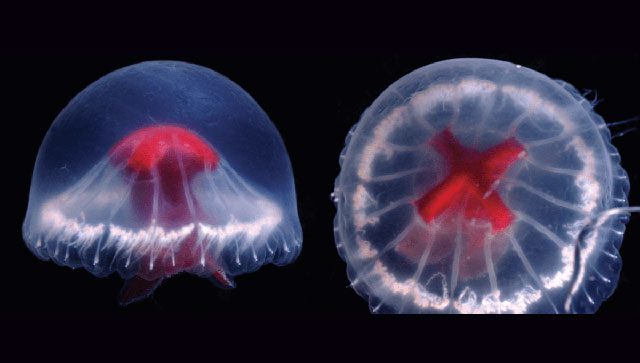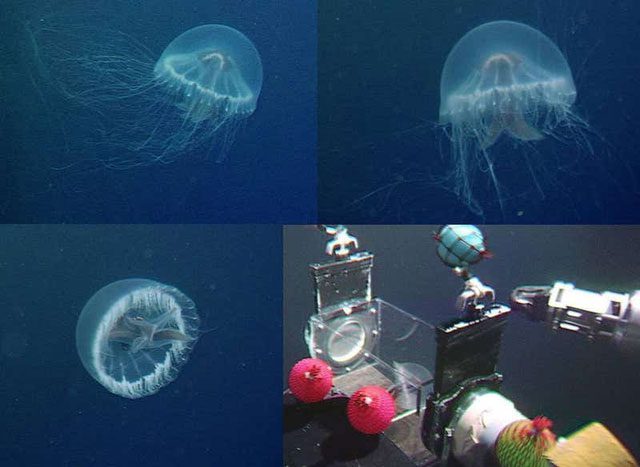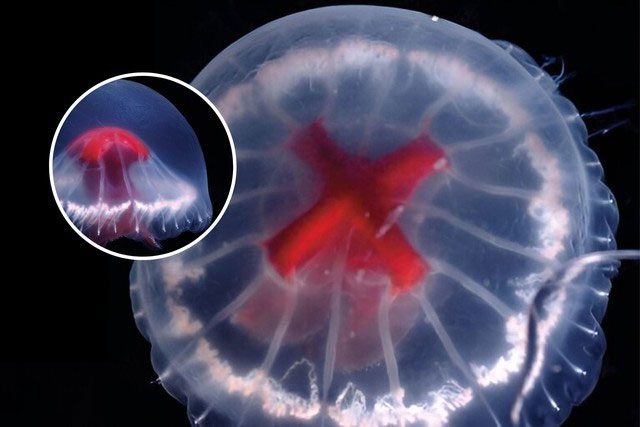A Strange Jellyfish Species Recently Discovered by a Team of Japanese and Brazilian Scientists in the Pacific Ocean.
George’s Cross Medusa (Santjordia pagesi or S. pagesi) is a newly discovered jellyfish species found at a depth of approximately 2,664 feet in the Pacific Ocean. It inhabits a deep-sea volcanic structure known as the Sumisu Caldera. This hydrothermal vent, which is about 6 miles wide, is located off the coast of the Ogasawara Islands in Japan, approximately 285 miles south of Tokyo. These findings were detailed in a study published last November in the journal Zootaxa.

This jellyfish exhibits unique physical characteristics that distinguish it from known species. The presence of a bright red cross-shaped stomach, along with its transparent body, tentacles, and special vein-like structures, contributes to its uniqueness. The name “Santjordia” is derived from Saint George in Catalan, symbolizing the distinctive cross-shaped stomach that sets this jellyfish apart.
The St. George’s Cross Medusa is considered quite large for a jellyfish, measuring about 4 inches wide and 3 inches long, with approximately 240 tentacles. It is named for the cross on its body that resembles the St. George’s Cross on the British flag when viewed from above.
It is a type of jellyfish, specifically a free-swimming jellyfish that has an umbrella-like shape with a reduced stalk.
“This jellyfish species is very different from all other deep-sea medusae discovered so far,” said André Morandini, co-author of the study and a biologist at the University of São Paulo in Brazil, in a statement: “The bright red color of the stomach is likely related to food capture.
Like all other jellyfish, S. pagesi has a transparent body. It also preys on other bioluminescent organisms in the deep sea that emit light. The research team believes that its bright red stomach acts like a shield to conceal its prey. This way, other organisms cannot see its meal after it has swallowed food.

The habitat of this jellyfish, found at significant depths of 2,700 to 2,800 feet near the Sumisu Caldera, combined with its pulsating movement for propulsion, has contributed to the understanding of its ecological niche and behavior.
While new species are continuously being discovered and described, this species is particularly rare. The research team faced difficulties in collecting specimens, so the study’s results are based on a single specimen. However, the team reportedly observed another S. pagesi nearby and hopes that future surveys will find more members of this group.
The specimen in the study was captured by a remotely operated vehicle (ROV) in 2002. In fact, the Sumisu Caldera can only be accessed via ROV due to its depth. Scientists did not observe any other specimens until 2020.
“We chose to publish the description and call attention to the species present at this site, which has a mineral-rich substrate and potential for commercial development. Unfortunately, research cannot be conducted in such places without partners interested in this type of research,” Morandini said.

This jellyfish species is found exclusively in the Sumisu Caldera, a volcanic caldera near the Ogasawara Islands, approximately 600 miles southeast of Tokyo, Japan. Its limited presence in this specific geographical area contributes to its rarity.
S. pagesi belongs to a new subfamily called Santjordiinae. It has small sensory structures called rhopalia underneath and along the edges of its umbrella, making it unique among jellyfish in the order Semaeostomeae.
Because it is so different from other jellyfish species, the authors of the study believe it may contain a “treasure trove of toxins” unlike those previously discovered in jellyfish. The Indo-Pacific box jellyfish secretes toxins that cause heart contractions, while the Australian box jellyfish can release toxins from tentacles that can reach up to 10 feet long.
“Who knows? Perhaps it holds secrets more valuable than all the mineral resources that could be extracted from there. All of this aims to preserve the species and the site.”, Morandini said.
Jellyfish are fascinating marine organisms belonging to the phylum Cnidaria, characterized by their distinct features and life cycles. Phylum Cnidaria: Jellyfish are part of the phylum Cnidaria, which includes many other marine animals such as sea anemones, corals, and hydras. They share certain structural and biological characteristics, such as radial symmetry and specialized stinging cells called cnidocytes. Body Structure: Typically, jellyfish have a bell-shaped body that is mostly transparent. Their bodies are composed of a jelly-like substance called mesoglea, and their shapes can vary greatly among different species, ranging from dome-shaped to cylindrical or umbrella-like. Tentacles: Hanging from the bell are numerous tentacles equipped with specialized cells known as cnidocytes. These cells contain nematocysts, tiny harpoon-like structures used to sting and capture prey. Movement: Jellyfish move by contracting and relaxing their bell-shaped bodies, propelling themselves through the water. Their rhythmic movement allows them to navigate and hunt for prey. Feeding: Jellyfish primarily feed on small fish, plankton, and other small marine organisms. When prey comes into contact with their tentacles, the stinging cells inject toxins to stun or paralyze the prey, making it easier for the jellyfish to consume it. Digestion and Waste Removal: Jellyfish have a single opening that serves as both mouth and anus. They ingest food through this opening and expel waste after digestion. Global Distribution: These fascinating organisms inhabit oceans worldwide, occupying various marine environments from shallow coastal waters to the deep sea. |


















































